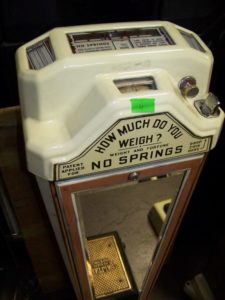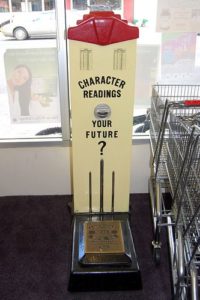There weren’t many things that a Boomer kid could spring for without bugging mom or dad for a nickel. Basically, such an item had to cost a penny. While nickels were hard for a kid to come by, pennies could be found in all sorts of places. You might spot one or two in the kitchen junk drawer. Digging in the dirt could possibly uncover one. It wasn’t unusual to spot a cent lying on the sidewalk.

So what could a kid do with a single penny, besides springing for a miniature Tootsie Roll?
He could take advantage of a finely-tuned scientific instrument that could be found in many small-town locations, drug stores in particular. He could spring for getting weighed.
The penny scale was a wonderfully massive thing to a kid. It was big, heavy, and stable. And it was just tall enough that it made a kid feel big to be able to see the weight window. Plus, a child with a penny could become a paying customer with no help from a parent, something that would make him feel grown up.
The penny scales were produced by the hundreds of thousands during the Great Depression, mainly (in the US) by rivals Peerless Scale Company and National Scale Company.
If a guy could scrape fifty bucks together during the 1930’s, he could make some serious money. That was the price of a brand new penny scale. Placing it in a well-traveled location could result in a cool 50-100 bucks a month. That was a pretty amazing turnaround on a modest investment! It’s hard to imagine that anyone ever got rich through penny scales, but they made for many a wealthy Depression-era entrepreneur.
After all, even in the economic darkness, EVERYBODY had a spare penny!
By 1950, inexpensive bathroom scales were readily available to consumers. Thus began the gradual disappearance of the ubiquitous street-corner scale.
But many businesses still had 40+ year-old scales in use in the 60’s. And hey, if they were bought and paid for, why not let them earn a few dollars per month?

Sadly, in the years since, they have pretty much vanished. So have the friendly corner drugstores that were the last havens of the massive weight-measuring machines. I defy you to spot a penny scale at Walgreen’s.
I recall that the scales would typically have a metal shade that would block the weight reading. Dropping a penny in the slot would cause it to move aside. If you really strained, you might be able to see your weight through a small crack that wasn’t covered by the shade.
The fancier models that would give you your fortune would have two movable shades, the second one being dislodged by a considerably more dear nickel. I’m not sure I ever wanted to know my fortune that badly, when I could get a Payday to munch on for the same price.
Other scales that I remember had trivia questions or horoscopes available in addition to your weight.
You can still find antique penny scales for sale. They have become hot collectibles, though, so don’t expect to obtain one for the original 50-dollar price tag.
For me, I’ll just have to close my eyes and take a virtual trip back to the Rexall Drug on Miami’s Main Street circa 1967. It feels good to drop my own penny in and become a paying customer.